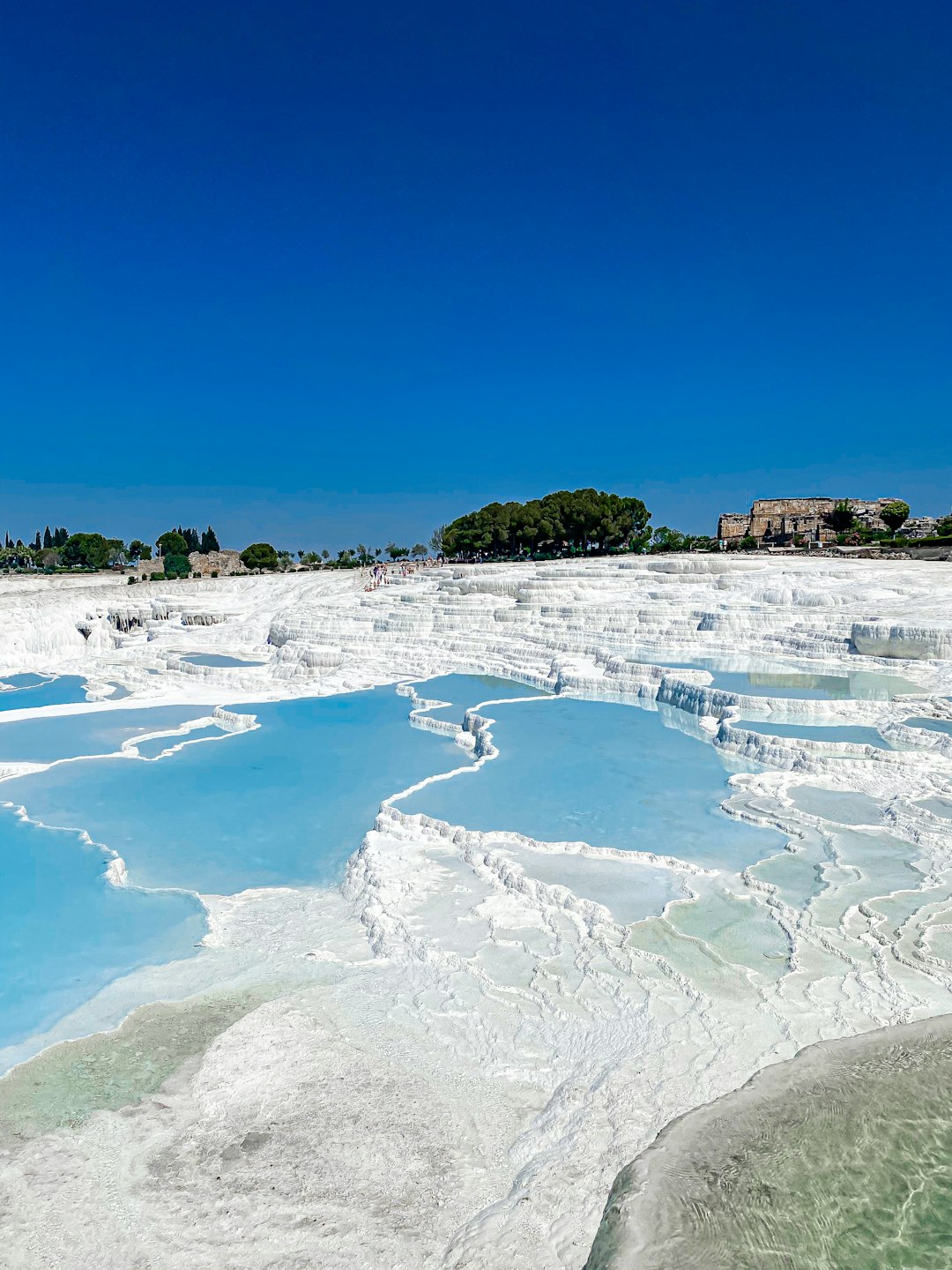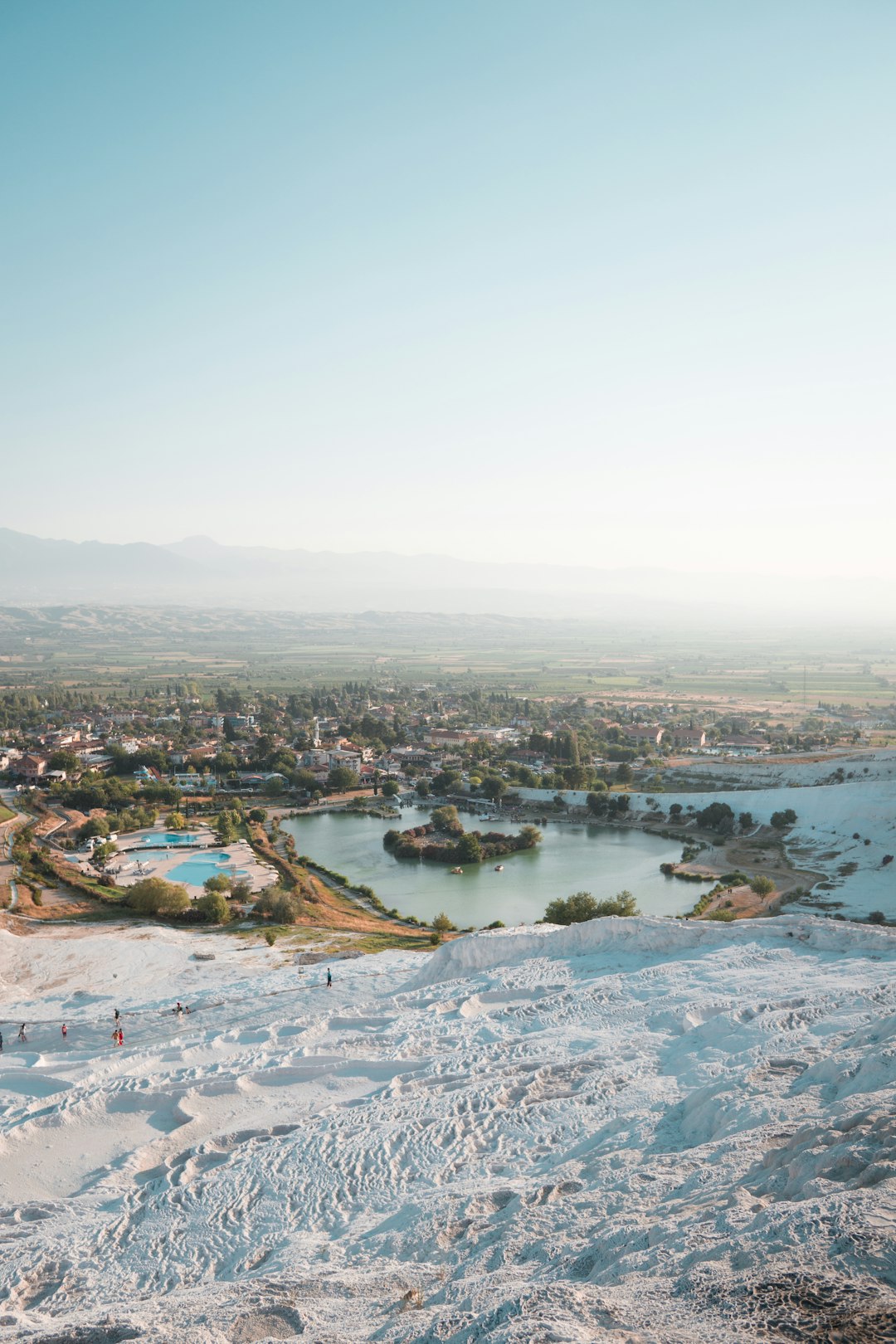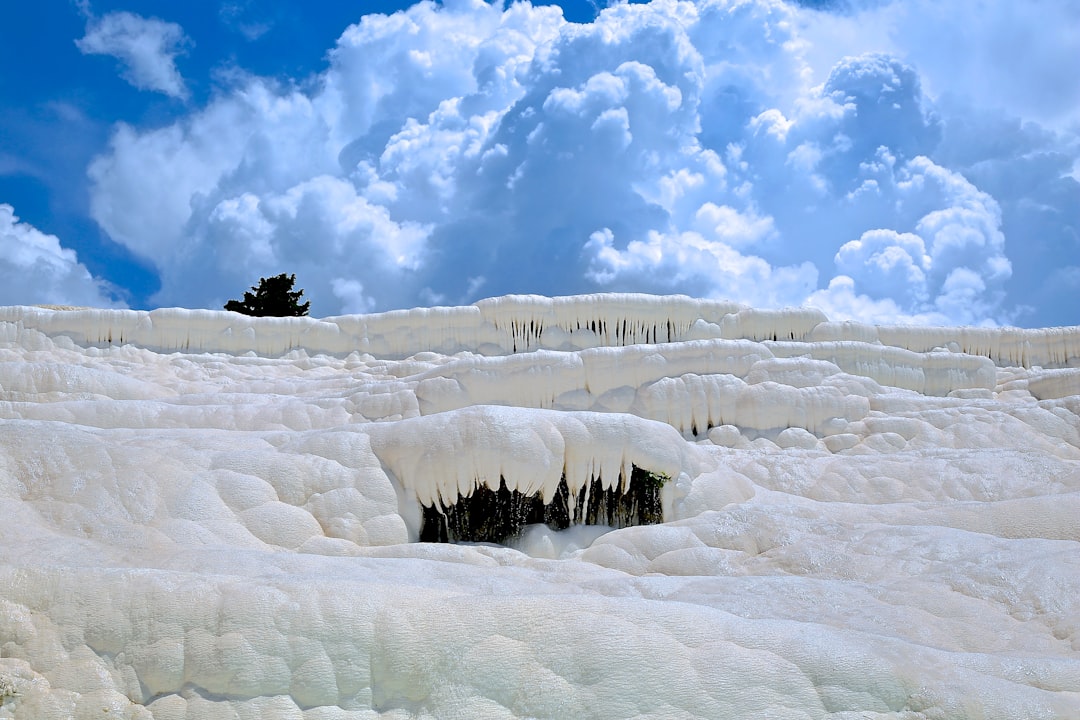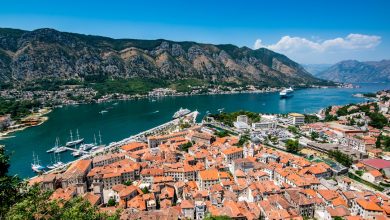
Steeped in rich history and breathtaking natural beauty, Pamukkale stands as a testament to nature’s artistry. In this comprehensive pamukkale travel guide, you’ll embark on an enlightening journey to Turkey’s “Cotton Castle,” where ethereal white terraces cascade down the mountainside. Whether you’re a history buff, wellness seeker, or simply in awe of natural wonders, Pamukkale promises an unforgettable experience. As we peel back the layers of time and myth, prepare to be captivated by the serenity and charm of this geological marvel, ensuring your visit is as seamless and enriching as possible.
Discovering Pamukkale: A Natural Wonder
Embarking on a journey to Pamukkale, a gem in Turkey’s treasure chest of natural wonders, is like stepping into a dreamscape. In this pamukkale travel guide section, we unveil the ethereal beauty that awaits at this stunning location.
Pamukkale, aptly known as “Cotton Castle” in Turkish, is a unique geological formation famed for its picturesque white terraces. These terraces are not snow, as they may appear from a distance, but are formed from travertine, a type of limestone deposited by mineral-rich thermal waters.
Why Pamukkale is a Must-Visit:
- Thermal Pools: The terraced pools, filled with warm, milky blue waters, offer an otherworldly bathing experience.
- Breathtaking Vistas: With its cascading waterfalls and terraces that look like fluffy clouds, the landscape is truly scenic.
- Photographic Paradise: Photographers find inspiration in its beauty, which shifts with the day’s changing light.
- UNESCO World Heritage Site: It’s not just a natural wonder, but also a place of historical and cultural significance.
As you plan your visit, remember to include this wonder in your itinerary through this essential pamukkale travel guide. Whether you’re a nature enthusiast, history buff, or simply in search of tranquility, Pamukkale promises a sublime encounter with nature’s artistry.
Moreover, it’s important to note the delicate nature of these formations. They require preservation efforts, so visitors are encouraged to explore responsibly, ensuring that Pamukkale continues to mesmerize travelers for generations to come.
In the next sections of our pamukkale travel guide, we’ll explore more about the rich history, travel tips, and the overall experience. Stay tuned, as each portion of this guide is designed to provide you with comprehensive knowledge to make your visit as memorable as possible.

The History and Mythology of Cotton Castle
Delving into history, Pamukkale, which translates to “Cotton Castle” in Turkish, is as rich in storytelling and legends as it is in beauty. This stunning natural wonder of terraced hot springs has been a focal point for civilization and mythical tales for the last two millennia, making it an integral part of any Pamukkale travel guide.
Origin and Historical Significance:
The formation of Pamukkale’s white travertine terraces began when warm, calcium-rich mineral water bubbled up from the earth and cascaded down the hillside, cooling and depositing as it flowed, giving rise to the dazzling white terraces that have drawn visitors from around the world. Across the ages, this site has drawn the attention of many, from ancient kings to modern travelers.
Mythological Roots:
- Apollo and the Prophecy: It is believed that the ancient city of Hierapolis, adjacent to Pamukkale, was founded by the god Apollo and named after Hiera, the wife of the founder of Pergamum. The area was known for its temple and oracle, reminiscent of Delphi, hinting at the divine belief that the waters had a connection to prophecy and the gods.
- Thermal Springs and Nymphs: A favorite story woven into the lore of Pamukkale involves the nymphs bathing in the warm, therapeutic pools. These mythical beings were said to restore their vitality in the mineral-rich waters, a tale that underscores the historic belief in the healing properties of the hot springs.
Cultural Heritage:
Pamukkale has been a UNESCO World Heritage Site since 1988, not solely due to its unique geological formations, but also its historical significance. The Greco-Roman city of Hierapolis was established here, taking advantage of the hot springs. Remnants of baths, temples, and other structures around the site tell of a rich cultural past that intermingles with the natural beauty of the terraces.
In any thorough Pamukkale travel guide, exploring the history and mythology associated with Cotton Castle are as much a part of the experience as witnessing its physical splendor. Here, travelers find themselves walking through layers of time, where each step along the travertine reflects a piece of the past, draped in legend and captivating human history.
Travel Tips Before You Go: Planning Your Visit
When preparing for a trip to Turkey’s stunning natural attraction, known as Cotton Castle, a comprehensive Pamukkale travel guide can prove indispensable. Here are a few travel tips to consider before you embark on your journey:
- Best Time to Visit: The ideal time to visit Pamukkale is during the shoulder seasons of spring (April to June) and fall (September to November). The weather is mild, and the site is less crowded compared to the high season in summer.
- Entrance Fees: Be prepared for the admission fees. As of my knowledge cutoff in 2023, Pamukkale has an entrance fee that may change, so it’s a good idea to check the latest prices before your visit.
- Dress Appropriately: Comfortable footwear is a must as you’ll be walking on travertine terraces which can be slippery. Also, remember to bring a swimsuit if you intend to take a dip in the thermal pools.
- Staying Hydrated: Carry a reusable water bottle. There are water fountains on site, and staying hydrated is crucial especially during the hotter months.
- Photography: Don’t forget your camera – the travertine pools offer breathtaking photo opportunities, particularly at sunset.
Here’s a comparison table summarizing what to pack:
| Must-Have Items | Optional |
|---|---|
| Comfortable walking shoes | Camera |
| Swimsuit | Turkish phrasebook |
| Water bottle | Sunhat |
| Sunscreen | Sunglasses |
Lastly, be mindful of your timing. Pamukkale can get particularly busy, so arriving early in the morning or later in the afternoon can help you avoid the largest crowds. This is especially true if you’re looking to capture unobstructed views and have a more peaceful experience exploring the terraces.
By following these tips from your Pamukkale travel guide, you’re set for an enjoyable and hassle-free visit to one of Turkey’s most enchanting destinations.
Exploring the Terraces: What to Expect at Pamukkale
Pamukkale, known colloquially as the “Cotton Castle” of Turkey, is a spectacle of nature’s artistry, attracting visitors worldwide. As you prepare to explore its terraces, this section of our Pamukkale travel guide will highlight what you can anticipate during your visit.
Once you set foot on the site, the stark white travertine terraces unfold before you, layered like a cascading waterfall frozen in time. The terraces are made of carbonate minerals left by flowing thermal spring water, which have created an expanse of billowing patterns.
Here’s what to keep in mind as you traverse this natural wonder:
- Thermal Pools: Be sure to dip your feet into the warm, mineral-rich waters that fill the terraces. These pools vary in depth and offer a surreal experience as you wade in them against the backdrop of the Turkish landscape.
- Footwear Rules: To preserve the delicate travertines, you’ll need to remove your shoes before walking on the terraces. It’s a unique sensation to touch the warm, textured surface with bare feet but remember to tread lightly.
- Photography: The terraces provide a breathtaking setting for photos, especially at sunset. However, be respectful and avoid setting up tripods or staging photoshoots in restricted areas.
Moreover, during your exploration, you may notice the careful balance that’s maintained to preserve this natural site:
| Preservation Effort | Visitor Guidelines |
|---|---|
| Water Flow Regulation | Designated Walking Paths |
| Restoration of Damaged Areas | No Access to Fragile Sections of Terraces |
By observing these regulations, you play a part in safeguarding Pamukkale’s beauty for the years to come.
Embarking on a journey through the terraces of Pamukkale is an unforgettable experience. Taking in the geological artistry and therapeutic qualities of the springs, your visit will surely be a highlight of your travels in Turkey. Keep this Pamukkale travel guide handy to make the most of your expedition among the clouds of the Cotton Castle.

Pamukkale’s Thermal Waters: Health Benefits and Healing Properties
As any seasoned pamukkale travel guide will tell you, the thermal waters of Pamukkale are not just a feast for the eyes; they have been renowned for their healing properties since ancient times. Here’s a glimpse into how these natural hot springs can contribute to your well-being:
- Skin Health: The mineral-rich waters are believed to help improve skin conditions, such as eczema and dermatitis. The waters’ soothing effects may also aid in reducing inflammation and nourishing the skin.
- Circulatory System: Immersing in the warm waters helps to stimulate blood circulation, which can be beneficial for heart health and lowering blood pressure.
- Musculoskeletal Problems: If you suffer from arthritis or rheumatism, the thermal waters could provide relief. The warm temperatures and minerals may help to relax muscles, reduce stiffness, and ease pain.
- Detoxification: Bathing in these famous terraces might assist in the body’s detoxification process by promoting sweating and the release of toxins.
- Stress Reduction: Beyond the physical benefits, there’s a soothing aspect to the geothermal waters of Pamukkale that can help reduce stress. The serene environment and the act of bathing itself can be meditative and calming to the mind.
While these benefits are widely regarded by visitors and local lore, it’s always important to approach natural remedies with a balanced perspective. Consulting with a healthcare provider before seeking thermal treatments for specific health conditions is recommended. Nonetheless, the allure of healing waters is a timeless draw for travelers, adding another layer of enchantment to the Pamukkale experience as detailed in this pamukkale travel guide.
Beyond the Terraces: Hierapolis Ancient City and Its Attractions
At the heart of Pamukkale’s allure lies not only its ethereal white terraces but also the rich historical tapestry of Hierapolis Ancient City. As integral to your journey as the natural wonders themselves, Hierapolis offers a captivating glance into the past, making it a must-see for every traveler. Here’s what your Pamukkale travel guide should not miss when it comes to exploring this ancient treasure:
- The Hierapolis Theatre: This well-preserved theatre boasts a capacity of 15,000 spectators. Its grandeur and intricate details stand as a testament to the artistry and engineering of the past.
- The Necropolis: Amongst the largest ancient cemeteries, the Necropolis is a striking collection of sarcophagi, offering profound insight into the diverse burial customs of different periods.
- Cleopatra’s Pool: Immerse yourself in legend as you swim in the thermal waters over ancient ruins, reputedly a gift from Marc Antony to Cleopatra.
- Hierapolis Archaeology Museum: Housed in the former Roman baths, the museum presents a fascinating array of artifacts and provides context to the city’s sprawling history.
Despite the undeniable ravages of time, Hierapolis—once a storied spa city—continues to capture the imaginations of visitors from across the globe. Its attractions combine seamlessly with the geological marvels of Pamukkale, making the inclusion of Hierapolis in your travel plans not just an option but an indispensable chapter of your journey.
Your pamukkale travel guide ought to stress the importance of setting aside enough time to appreciate both the natural and man-made marvels. With each step on its ancient stones, visitors walk along the very paths where history was once made, ensuring a rich and immersive experience that transcends the mere visual splendor of Pamukkale’s terraces.
Accommodation Options Near Pamukkale: Staying Comfortably
When planning your visit to one of Turkey’s most spectacular natural wonders with the help of this pamukkale travel guide, finding the perfect place to stay is crucial for a comfortable and enjoyable experience. Pamukkale offers a range of accommodation options to suit various budgets and preferences. Here are some suggestions:
- Budget Hotels: For travelers looking to save on lodging, budget hotels provide basic amenities without sacrificing comfort. Most offer easy access to Pamukkale’s main attraction, the travertine terraces.
- Mid-range Inns: Ideal for those seeking a balance between cost and comfort, mid-range inns often feature additional facilities such as swimming pools, onsite restaurants, and more spacious rooms.
- Luxury Resorts: Pamukkale also caters to those desiring a touch of luxury. High-end resorts typically boast thermal pools, spa services, and exquisite rooms, elevating your stay to a memorable holiday.
- Boutique Accommodations: For an authentic and unique experience, consider boutique lodgings that reflect local charm and hospitality.
| Budget Friendly | Mid-range Comfort | Luxury Experience |
|---|---|---|
| Hostel Anatolia | Hotel Pamukkale | Doga Thermal Health Spa |
| Bellamaritimo Hotel | Venus Suite Hotel | Richmond Pamukkale |
| Melrose House Hotel | Hierapark Thermal Hotel | Pamukkale White Heaven |
When selecting your accommodation, keep in mind the following:
- Proximity: Staying close to the Pamukkale Hierapolis Archaeological Park allows for effortless exploration. However, the town of Denizli, located 20 minutes away, is also a viable alternative.
- Amenities: Confirm whether the desired hotel offers amenities like free Wi-Fi, breakfast options, and travel assistance for local excursions.
- Reviews: Look at recent guest reviews to better gauge the quality of your potential stay.
Remember, this pamukkale travel guide isn’t just about the sights; it’s about ensuring a restorative retreat after a day of exploration.Booking in advance, especially during the peak tourist season, is highly recommended to secure your ideal accommodation.

Dining in Pamukkale: Local Delicacies and Where to Find Them
When traveling through Pamukkale, a true taste of local culture is found not only in the stunning vistas but also in the rich flavors of its regional cuisine. To fully immerse yourself in the experience, let this Pamukkale travel guide walk you through the labyrinth of delectable local delicacies and where to partake in these culinary treasures.
Here are some must-try dishes and tips on finding the perfect dining spots:
- Gözleme: This savory traditional Turkish flatbread, filled with ingredients like spinach, cheese, or potatoes, is best enjoyed at small eateries where it’s made fresh in front of you.
Where to find it: Local bazaars and street-side vendors.
- Manti: Often referred to as Turkish ravioli, these tiny dumplings filled with minced meat and topped with yogurt and spices, can be savored at family-owned restaurants.
Where to find it: Traditional Turkish diners.
- Kebabs: A variety of kebabs, including the famous ‘Iskender’ kebab, are staples in Turkish cuisine and are available at most of the restaurants in Pamukkale.
Where to find it: Grill houses (kebapçılar) and diners.
- Baklava and Turkish Delight: For those with a sweet tooth, no Pamukkale travel guide would be complete without mentioning where to find these sugary delights.
Where to find it: Confectioneries and cafes.
Pro Tips:
- Opt for places that have a lot of local patronage; they’re likely to serve the best and most authentic dishes.
- Don’t hesitate to ask for recommendations from locals or your accommodation hosts—they’re often the best source for uncovering hidden culinary gems.
By integrating these delicacies into your itinerary, your visit to Pamukkale will be as much a feast for your palate as it is for your eyes. Remember, tasting the local cuisine is a gateway to understanding the heart and soul of the region. So delve into Pamukkale’s dining scene and let your taste buds lead the way to a memorable cultural experience.
Responsible Tourism: Preserving Pamukkale for Future Generations
As one of the most breathtaking natural sites in Turkey, Pamukkale has become a popular destination for travelers worldwide. Responsible tourism is key to preserving this unique location for future generations. When creating a pamukkale travel guide, it’s important to emphasize ways tourists can help maintain the beauty and integrity of these natural wonders. Here are a few responsible tourism tips to keep in mind:
- Stick to the Pathways: Pamukkale’s famous terraces are delicate structures. For their preservation, it’s essential that visitors stay on the marked pathways and avoid walking on the travertine pools.
- Respect the Natural Environment: Take nothing but pictures, leave nothing but footprints. Ensure that you dispose of waste properly and refrain from littering to keep the area clean and pristine.
- Support Sustainable Practices: Choose accommodations and tour providers in Pamukkale that are committed to sustainable tourism practices, thereby contributing to the site’s long-term preservation.
- Conserve Water: Even though Pamukkale is renowned for its water, it’s still a precious resource. Use it sparingly whenever you can, particularly in hotels and other facilities in the area.
- Educate Yourself and Others: Learn about the geological and historical significance of Pamukkale and share that knowledge with others to raise awareness about its conservation.
- Engage with Local Businesses: Opt to support local artisans and businesses that contribute to the local economy without exploiting the region’s resources.
By following these suggestions, each visitor can play a part in the conservation efforts of this incredible site. A pamukkale travel guide should not only showcase the splendors of the “Cotton Castle” but also encourage travelers to act as stewards of nature, ensuring that future travelers will have the same opportunity to experience the wonder of Pamukkale.



